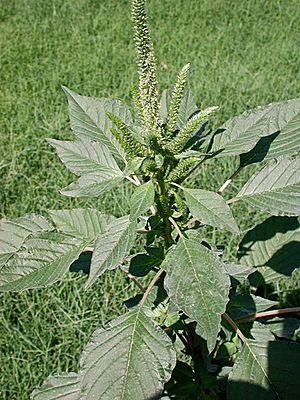Amaranthus palmeri facts for kids
Quick facts for kids Amaranthus palmeri |
|
|---|---|
 |
|
| Scientific classification | |
| Genus: |
Amaranthus
|
| Species: |
palmeri
|
Amaranthus palmeri is a type of flowering plant. It belongs to the amaranth family. You might hear it called carelessweed or Palmer's amaranth. This plant naturally grows in the southern half of North America. It has also spread to places like Europe and Australia. It grows very fast and can take over areas quickly.
Contents
Uses of Palmer Amaranth
The leaves, stems, and seeds of Palmer amaranth are edible. They are also very healthy, just like other amaranth plants. Long ago, Native Americans in North America ate Palmer amaranth a lot. They used its many seeds and cooked or dried its green leaves. Other types of amaranth have been grown for thousands of years. People in Mexico, South America, Africa, and Asia have used them for food.
This plant can be harmful to farm animals like cows. This is because its leaves can have high levels of nitrates. If Palmer amaranth grows in soil with too much fertilizer, it can absorb a lot of nitrogen. This can make it unsafe even for humans to eat. Like spinach, amaranth leaves also contain oxalic acid. Eating too much of this can be bad for people with kidney problems.
Today, people in the United States rarely eat Palmer amaranth. This is because it can be toxic to animals. Also, many people don't know it can be eaten. It grows everywhere and can handle dry weather well. Unlike other amaranth plants, it hasn't been specially grown for food. So, farmers in America see Palmer amaranth mostly as a noxious weed. It competes with their important crops.
Palmer Amaranth as a Weed
Palmer amaranth is a big problem for farmers. It especially threatens cotton and soybean crops in the southern United States. In many areas, this plant has become resistant to glyphosate. This is a common chemical used to kill weeds. Since 2006, many Palmer amaranth plants can survive glyphosate. This resistant weed causes problems for many different crops.
In 2014, the Texas Department of Agriculture asked for special permission. They wanted to use a strong chemical called propazine. This was to protect cotton fields from Palmer amaranth. But the request was turned down. This was because it could harm drinking water.
In 2019, scientists in Kansas found Palmer amaranth that could resist other chemicals. These chemicals were 2,4-D and Dicamba. Before this, Palmer amaranth in Kansas had already resisted other weed killers. This leaves farmers with very few ways to control this tough weed.
How Palmer Amaranth Grows
Palmer amaranth is one of the fastest-growing weeds. It can grow much faster than crops like cotton. It is also very good at taking nutrients from the soil. This weed can grow 2 to 5 inches (50 to 127 mm) in just three days. In a few weeks, it can reach 12 to 18 inches (305 to 457 mm) tall. Cotton plants only grow about 5 to 8 inches (127 to 203 mm) in the same time. This fast growth makes it hard for crops to get enough water. Many weed killers also stop working in very hot weather.
How Palmer Amaranth Spreads
The pollen from male Palmer amaranth plants is carried by the wind. This pollen then reaches female plants. The female plants then make seeds. These seeds can spread in many ways. They can spread during harvesting crops. They can also spread if farm equipment is not cleaned well. Even animal waste can spread the seeds.
In 2014, a guide for weed control in North Dakota named Amaranthus palmeri the "weed-of-the-year." This was to help people understand how harmful it could be. In 2015, it was chosen again. This was to help stop it from growing in North Dakota.
See also
 In Spanish: Amaranthus palmeri para niños
In Spanish: Amaranthus palmeri para niños


